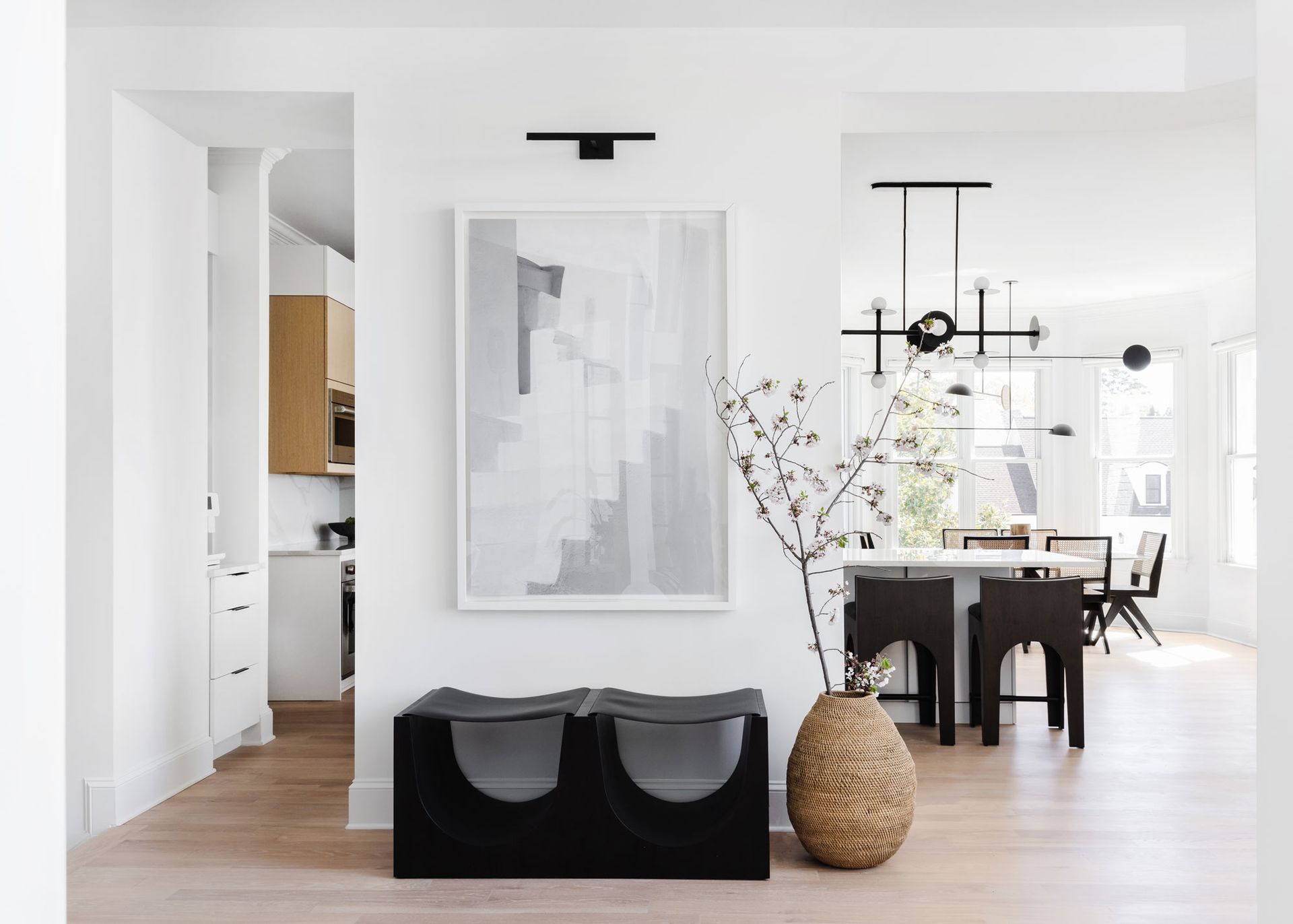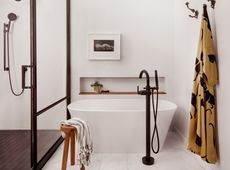These are the biggest flooring mistakes you can make. Here's how to avoid them
Are you guilty of making these mistakes when choosing new flooring for your home? Experts give us the low-down of how to avoid these pitfalls


Making a serious mistake with your flooring can be catastrophic, and not only because it can ruin the look of a beautifully decorated home. While some home decorating is easy to fix if something goes awry, flooring is more challenging to make good. Plus, it can be a huge expense.
From warping to scratches, dents, and stains, there is a multitude of issues that can go wrong once your flooring is installed, but some of the biggest mistakes can be made before you've even laid it. One important aspect to keep in mind is to not compromise on the quality of materials. While you may think you're saving big bucks, the constant maintenance, repairs, or even eventual reflooring could break the bank. Consult an expert if need be, and give your flooring as much importance, thought, and consideration as you would to, say the furniture, paints, or countertops.
Do a deep dive into floor types, finishes, and layouts, and make a well-informed decision for your floors. Before you buy, take a look at the top mistakes that experts say are most commonly made, to ensure you're making the right decision from the get-go.
7 flooring mistakes to avoid
1. Choosing flooring without taking the room's function into account

Don't choose flooring that's impractical for your home. While it's great to look for creative flooring ideas for every room, do keep the durability and use of the room in mind as well. The kitchen for instance is a hardy space that takes a lot of beating (spills, stains, etc). For this room, glass tiles or mosaics would be wrong.
'Flooring is a long-term commitment, so the type of flooring you choose will depend on the function of the room in question,' says James Scully, founder of Recork. 'In a bathroom, it needs to be a material that can withstand high moisture, compared to in a hallway or kitchen which is a high traffic area that needs to be durable and hardwearing. Natural materials are a great choice to use in the home as they not only add an organic element, but are practical and sustainable; as long as you research the retailer and look into the manufacturing process.'
'For high traffic areas, cork is a truly versatile material that is easy to look after,' says James. 'The material itself is extremely sustainable, plus the lacquer which is applied as the top coat gives the product extra strength meaning it lasts longer and doesn’t need to be changed as often.'
2. Opting for the wrong tile finish

Tile finishes or different effects on the surface of a tile can affect their use. Polished ones with increasingly finer pads have a smooth and shiny surface, perfect for adding a touch of luxury and glamour to a formal or traditional space. Marble, for instance, is often polished. Satin finishes are also similar but have a softer and less shiny appearance, the perfect balance between polished and honed.
Honed tiles have a smooth matte finish, ideal for high-traffic areas that require anti-skid flooring. Finally, a brushed finish has an orange peel-like finish, usually seen in stone flooring, and handle wear and tear; another good contender for busy rooms.
Fortunately, you don't have to guess whether a tile is a good choice for flooring, especially in areas prone to slipping. Tile manufacturers offer a COF rating which relates to how much friction a tile provides, and retailers will usually outline whether a tile is a good choice for flooring.
'You should choose evergreen, subtle, and visually-pleasing tiles because it's a huge task to re-floor the house frequently,' say Rashi Bothra & Ruchi Gehani, founders and interior designers at Azure Interiors. 'People should choose the right tile finish for the right place in the house. For instance, the bathroom cannot have glossy tiles.'
3. Not allowing wood flooring to acclimate

The important thing to know about wood flooring is that it expands and contracts as the temperature in your home changes. When laying your floor, it's important that you allow your flooring to acclimate to your home beforehand, or else you could be left with warping or gaps between planks.
It's also important to leave a gap around the edge of a wooden floor - one that can be covered with your baseboard when laid - so that if your flooring expands, it doesn't cause warping. This should be around 3/8 to 5/8 inches, but can be slightly less for an engineered wood floor which has a higher threshold for expanding.
4. Picking too large or too small tile formats

The tile size should be relative to the size of your space. A large open floor space will look good with large tiles while a medium or small room will do better with smaller tiles or mosaics. The opposite, however, will make the room look awkward and mismatched.
Large tiles of at least 12-18 inches can make a room appear larger. When you have a medium to large space, bigger tiles will expand the space and make it feel more open; checkered flooring is a good option in this case. Tiny tiles, like mosaics, work well in bathrooms. Keep in mind that small tiles also mean more grout lines so, in small spaces, it's ideal to match the grout color with the tiles so the floor looks seamless.
'When tiling the home, people often make the mistake of not choosing the right sized tile, design, and grout color,' says Amanda Telford of CTD. 'When working with a restricted area, large format tiles can create the illusion of a bigger space and when paired with the same-colored grout it can create a free-flowing feel. We always recommend opting for tiles and a grout that will accentuate a small area rather than make it feel restricted and busy.'
'Geometrical shape tiles, larger or smaller scale, can be used to make unique and fun patterns and emphasize feature areas and paths,' says interior designer Iman Lalji. 'Mosaic tiles also look bold and luxurious. Placing them on just one part of the floor or on the entire kitchen floor will enrich the room and offer an amazing detail.'
5. Not sealing natural stone tiles

Let’s make one thing clear. If you have natural stone, you need to seal it. This is because the stone is porous, and absorbs spills, water, food particles, and more throughout its lifespan. Not sealing it, especially if it's laid out in heavy traffic areas, can leave the surface vulnerable, and weaken the stone, potentially leading to the growth of bacteria. While this is true for flooring, if you have a natural stone or marble kitchen countertop, that needs to be sealed often as well.
'Like any natural stone, marble tiles need sealing at the point of installation due to their porosity,' says Louisa Morgan, creative director at Mandarin Stone. 'We would advise against using any harsh detergents as these can strip the sealants. We would suggest less abrasive cleaners like Fila Cleaner.'
6. Using the wrong cleaning solutions

Every floor is different, as are flooring materials, finishes, and even the way they are installed. To clean your floor tiles, make sure you know what kind of material it is. For instance, when you mop wood flooring, keep the amount of soapy water to a minimum and instead, use a cleaning product made for wood. Similarly, a tile cleaner for porcelain or ceramic tiles won't work on natural stone tiles – the high level of acidity in these cleaners can damage them.
'A good homemade cleaning solution is one part bleach and four-parts water,' says Rajesh Bhandari, director at A-Class Marble. 'Otherwise, you can buy a Ph neutral cleaner to sanitize your floor. Using non-acidic products and floor sealants to seal your stone can be a good precautionary move to avoid spillage stains. For marble, polishing is a smart way to reduce the stone's absorbency and hence prevent your flooring from dust accumulation.'
7. Not ordering enough flooring

One of the most common mistakes people make is taking incorrect measurements of the room, and therefore landing with either a shortage of flooring materials or an excess of them.
One good way to do this is by using a measuring tape to determine the room's length and width; then multiplying the length by the width to get the total square footage. If you still aren't sure, either rope in a professional to help you out, or seek out interior design apps that can do the work for you.
What causes soft spots on flooring?

More often than not, soft spots on the floor are due to either water damage, water stains, or termite infestation; and if you have dark tiles or floor paints, chances are they'll show even more.
Spots can also appear if the flooring hasn't been installed properly. If you see that there’s a difference in height between one area of laminate and another, then the chances of spots occurring are higher. Alternatively, if you have laminate flooring, with no gap between your sub-floor and underlayment, the expansion could cause spots. It also occurs because wood absorbs moisture which causes warping.
Should flooring be the same in all rooms?
Ideally, you don't need to change the flooring in every room. A home that has a uniform, seamless flooring looks just as nice, aesthetic, and smart. If you have a small home, it's best to have the same flooring running throughout as it will create a feeling of expansion and depth, with endless sightlines extending across rooms. However, if you still are keen to have different flooring options for one or two rooms, ensure you choose materials and finishes suited to that space. Choose anti-skid tiles for the bathroom; durable and strong floor tiles for the kitchen and so on.
Be The First To Know
The Livingetc newsletter is your shortcut to the now and the next in home design. Subscribe today to receive a stunning free 200-page book of the best homes from around the world.
Aditi Sharma Maheshwari is an architecture and design journalist with over 10 years of experience. She's worked at some of the leading media houses in India such as Elle Decor, Houzz and Architectural Digest (Condé Nast). Till recently, she was a freelance writer for publications such as Architectural Digest US, House Beautiful, Stir World, Beautiful Homes India among others. In her spare time, she volunteers at animal shelters and other rescue organizations.
-
 People With Spa Bathrooms Will Likely Have These 8 Things — Get the Look With Our Checklist
People With Spa Bathrooms Will Likely Have These 8 Things — Get the Look With Our ChecklistHomeowners with spa-like bathrooms typically have these seven things, how many do you have?
By Oonagh Turner Published
-
 7 Vegetables You Can Plant in February – Our Favorite Varieties That Can be Either Sown or Planted Outdoors Now
7 Vegetables You Can Plant in February – Our Favorite Varieties That Can be Either Sown or Planted Outdoors NowGet planting these easy salad and vegetable varieties now and you will soon have plenty of fresh early spring crops
By Sarah Wilson Published

